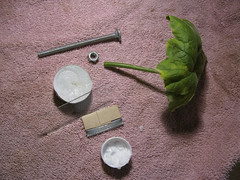They also cost actual cash money...from an economical $69.75 for this 'Hand Microtome' from The Science Company. Which says that one turn of the base will create a 0.5mm section, and is calibrated to create 10 micron sections, so 1/50th of a turn = 10 microns, a full turn = 500 microns or .5 mm.
Or you can spend $12,445 for a unit which can create, a 0.5 micron section.
But building from the DIY philosophy, you can build a pretty nifty Microtome with with a bit of wax a 1/4" - 20 nut and bolt, and a razor blade! With all credit, like many good DIY ideas, this one comes from an older book. See below for details...

Read on to learn how!